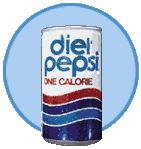Interrogating the Diet Pepsi...
 Claude Frédéric Bastiat was a French liberal economist of the early 19th century, he is probably best known for the "Broken Window Fallacy." Essentially he constructs a narrative in order to illustrate the point that there are opportunity costs that are often not immediately visible and as such it is necessary that good economists become aware of, in an anachronistically postmodern way...Ce qu'on voit et ce qu'on ne voit pas, "that which we can see and that which we don't." Economics, that most dismal of sciences as suggested by that most bearded of sages Thomas Carlyle, is often perceived as the science of revealing the mundane in the everyday in excruciatingly mathematical detail. However, Steven Leavitt, author of Freakonomics has taken Bastiat's rule to heart in his work and revealed in interesting and occasionally controversial ways what lies below the commonplace. This disclosure is often paradoxically liberating and annoyingly confusing.
Claude Frédéric Bastiat was a French liberal economist of the early 19th century, he is probably best known for the "Broken Window Fallacy." Essentially he constructs a narrative in order to illustrate the point that there are opportunity costs that are often not immediately visible and as such it is necessary that good economists become aware of, in an anachronistically postmodern way...Ce qu'on voit et ce qu'on ne voit pas, "that which we can see and that which we don't." Economics, that most dismal of sciences as suggested by that most bearded of sages Thomas Carlyle, is often perceived as the science of revealing the mundane in the everyday in excruciatingly mathematical detail. However, Steven Leavitt, author of Freakonomics has taken Bastiat's rule to heart in his work and revealed in interesting and occasionally controversial ways what lies below the commonplace. This disclosure is often paradoxically liberating and annoyingly confusing.
Economic processes often seem mysteriously complex and more to the point their explanations make arbitrary, highly mediated, and totally surprising logical associations, much like the price of tea in China. But it is these very types of associations that exemplify the rather beautiful and staggering nature (perhaps even frightening) in which individuals are enmeshed in our swiftly flattening globe. Thomas Friedman documents this process fluidly if a bit colloquially in his latest work, The World is Flat. It becomes apparent that what lies below the everyday is far from mundane, if what is meant by mundane is boring or unimportant. While it could be quickly added that the smooth and highly readable prose of Friedman and Leavitt belie a considerably more circuitous and numerically nuanced picture, the social and political ramifications of this work, the statistical data orgy that it is, are undeniably important.
A few weeks ago, I purchased a fridge-friendly twelve-pack, of Diet Pepsi for $2.49 plus tax. Diet Pepsi was initially produced in 1964 as a sugar-free variant of its carbonated cousin. Today it is a deliciously refreshing aspartamed concoction with zero calories and carbs. In the twelve pack I purchased, one of the cans, which otherwise resembled its 11 other friends, despite being sealed had much less than the requisite 12 oz. of the light and crisp goodness that I had come to expect. My original indignation at the absence of the carbonated beverage was replaced with a sense of surprise and confusion, how could this happen? It is not as if John Boy at the plant had had one too many Lowenbraus the night before at the Overtime Pub and was off his can-filling game the next day, leaving my container pathetically under-filled. This process had long been automated and I had thought, erroneously, perfected. Yet here in all its light blue aluminum glory it was, its existence mocking all that is holy about product dispersion technology.
Russell Roberts, a professor of economics at George Mason, and author of the economic romance novel, The Invisible Heart, wrote a brief article that read more like a love letter to the Pepsi plant, and waxed poetic as much an economist is liable to do about the marvelous vessel-filling techniques that Pepsi and presumably by extension Coca-Cola utilize. In his effusion of schoolgirl-like admiration of the invisible in the visible in the purchase of a can of Pepsi, he offers that despite the 1.5 billion cans a year that this massive plant will pump out (oddly sexual isn't it, this tone is much more his than mine I assure you), the chance of encountering a half-filled or God forbid unfilled can will be minimal "once-in-a-lifetime" as a result some type of gamma-ray/crystal sensor device which measures photon absorption rates of the can. Further he suggests that such a gargantuan plant requires only a skeleton staff of approximately 15 workers to maintain the behemoth operation on a daily basis.
But, the mostly empty can remains, its contradicting presence foregrounding the invisible, bringing it into the bright light of day...pressuring, questioning the invisible to reveal its worst truths. This can, this hermeneutic tear in the otherwise smooth narrative weave of Leavitt, Roberts, and Friedman, through which the usually dulled and cowed eyes of the consumer might be able peer into the chasm of the Bastiat's invisible and interrogate the plausibility structure, and lay bare the very "human" processes which populate this not so flat, and maybe not so Freakishly efficient space, perhaps?
1 comment:
Chaos theory meets freakonomics. First an empty Diet Pespi can, next cloned dinosaurs running amok. Mark my words.
Post a Comment